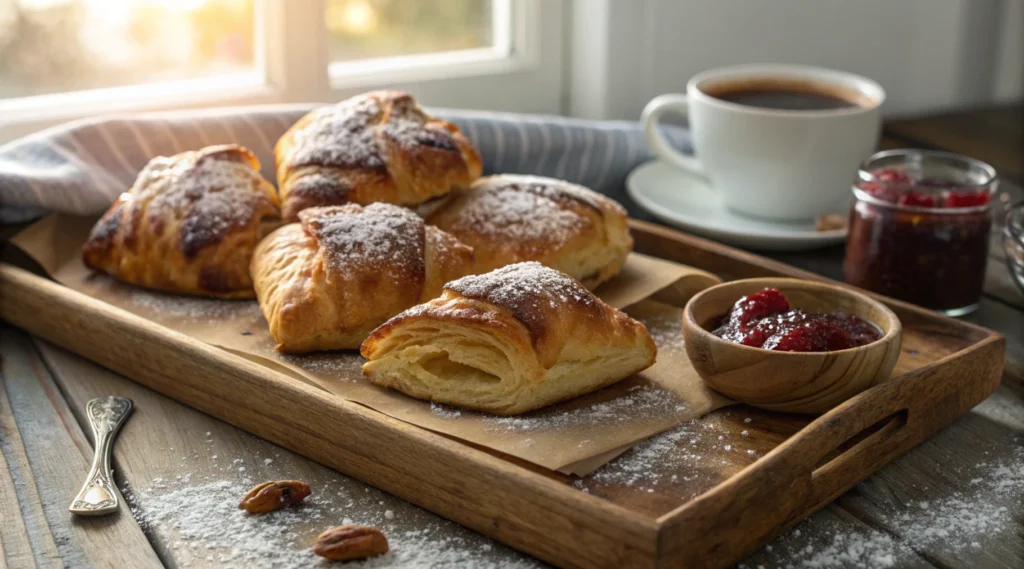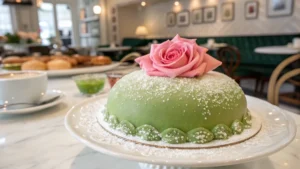Introduction: Mastering the Gipfeli Recipe
Gipfeli, the Swiss cousin of the French croissant, is a buttery, flaky delight that’s cherished for its rich texture and versatility. In this guide, we’ll teach you how to master the Gipfeli recipe step by step, ensuring your pastries turn out as perfect as those from a Swiss bakery. Whether you’re preparing for a cozy breakfast or an elegant brunch, this Gipfeli recipe is your go-to guide for creating authentic, flavorful Swiss pastries
What is Gipfeli?
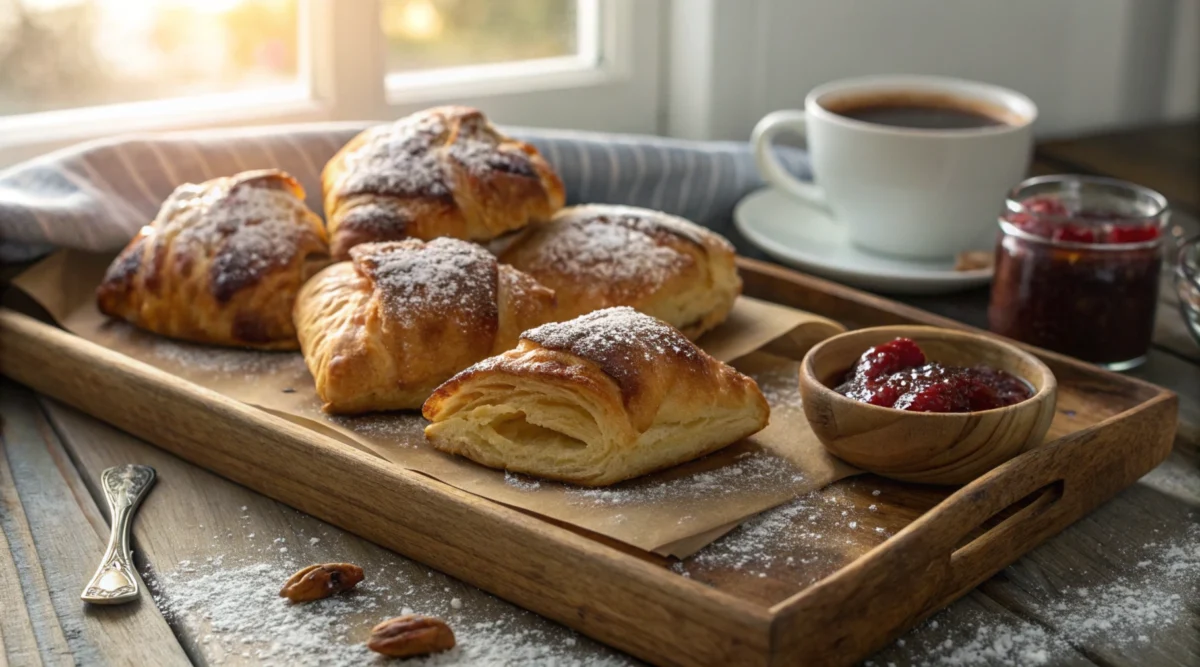
Gipfeli is a traditional Swiss pastry that resembles a croissant but with a slightly denser texture and less sweetness. Loved for its buttery layers and golden exterior, this pastry is a breakfast staple across Switzerland. Unlike the French croissant, Gipfeli offers a heartier bite, making it equally delightful as a savory snack or a sweet indulgence.
A Brief History of Gipfeli and Its Swiss Roots
The story of Gipfeli begins with the European fascination with laminated dough. While the French perfected the croissant, the Swiss adapted it to suit local tastes. Over time, Gipfeli became a symbol of leisurely Swiss mornings and a beloved treat served in cafes and homes alike. This rich culinary heritage ensures every bite of Gipfeli carries a sense of tradition and comfort.
Why Make Gipfeli at Home?
There’s something magical about the smell of freshly baked Gipfeli wafting through your home. Making Gipfeli from scratch allows you to control the quality of ingredients and tailor the recipe to your taste. Plus, the satisfaction of pulling these golden beauties from your oven is unmatched. Ready to impress your family and friends? Let’s start baking!
Essential Ingredients and Tools for Gipfeli recipe
Key Ingredients for Gipfeli Dough
The heart of Gipfeli lies in its dough. Using the right ingredients is crucial for achieving the perfect flaky texture:
- Flour: Choose high-quality all-purpose or bread flour for better structure and elasticity.
- Butter: Unsalted European-style butter with a high-fat content delivers richer layers.
- Yeast: Fresh yeast is ideal for authenticity, but active dry yeast works well, too.
- Milk: Whole milk adds richness and tenderness to the dough.
- Sugar and Salt: These balance flavor, adding a touch of sweetness and depth.
Importance of High-Quality Butter in the Gipfeli recipe
The secret to mastering a perfect Gipfeli recipe lies in using high-quality butter. Butter isn’t just an ingredient; it’s the cornerstone of the flaky layers and rich flavor that define this classic Swiss pastry. For any authentic Gipfeli recipe, opting for unsalted European-style butter with a high-fat content is non-negotiable.
Why is this important? High-fat butter has a creamier texture and less water content, which ensures the pastry’s layers remain distinct and tender during baking. If you’re aiming to perfect your Gipfeli recipe, always ensure the butter is cold. Cold butter prevents it from melting into the dough prematurely, helping create the pastry’s signature flakiness.
Avoid low-fat butter or margarine as they lack the richness and quality needed for the ultimate Gipfeli recipe. The choice of butter can make or break your pastry, so invest in the best to achieve those golden, buttery layers that will wow anyone who tastes them.
Necessary Baking Tools
To make the process smooth and enjoyable, gather these essential tools:
- Stand Mixer with Dough Hook: Perfect for kneading.
- Rolling Pin: For evenly laminating the dough.
- Pastry Brush: Helps apply an egg wash for that golden crust.
- Baking Sheet and Parchment Paper: Prevents sticking and ensures even baking.
Setting Up Your Workspace
Before you begin, prepare a clean, spacious surface. Chilling the rolling area or using a marble board helps keep the dough cool during lamination. A well-organized workspace makes the process seamless, leaving you to focus on crafting those irresistible Gipfeli.
Preparing the Gipfeli Dough
Mixing the Ingredients
The foundation of perfect Gipfeli starts with a well-prepared dough. Combine the flour, sugar, salt, and yeast in a large mixing bowl or the bowl of a stand mixer. Gradually add the warm milk, mixing on low speed until the ingredients form a cohesive dough. Then, switch to medium speed and knead until the dough is smooth and elastic, about 8–10 minutes.
Pro Tip: If kneading by hand, flour your surface lightly to prevent sticking but avoid over-flouring to keep the dough soft.
The First Dough Rise: Tips and Tricks
Transfer the dough to a lightly greased bowl. Cover it with a damp cloth or plastic wrap and let it rise in a warm, draft-free spot until it doubles in size. This usually takes about 1–2 hours, depending on the room temperature.
Gipfeli pro tip: If your kitchen is cool, place the bowl in a slightly warmed (but off) oven to help the dough rise more consistently.
Laminating the Dough: Incorporating Butter
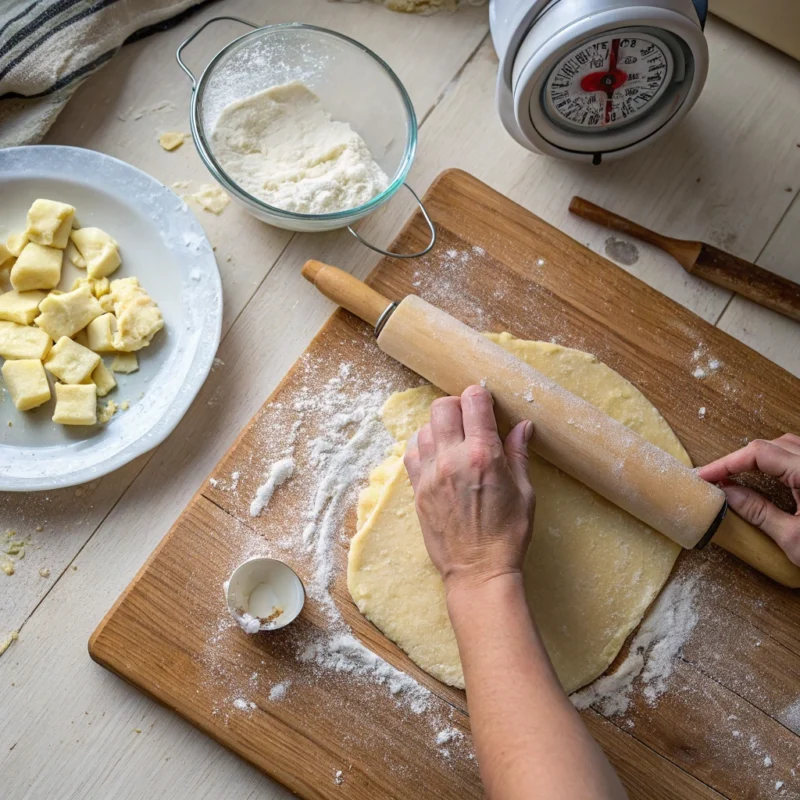
Lamination is where the magic happens. Roll out the risen dough into a rectangle, roughly 12×18 inches. Place thin slices of cold butter over two-thirds of the dough. Fold the unbuttered third over the center, then fold the opposite buttered side over it, like folding a letter.
Turn the dough 90 degrees, roll it out gently, and repeat the folding process twice more. Be sure to chill the dough in the refrigerator for 20–30 minutes between folds. This keeps the butter firm and helps create the distinct, flaky layers that define Gipfeli.
Resting for Success
Wrap the laminated dough in plastic wrap and refrigerate for at least 4 hours or overnight. This resting period allows the gluten to relax and enhances the pastry’s texture.
Shaping and Baking the Gipfeli
Rolling and Cutting the Dough
After the dough has rested and the butter is well-incorporated, roll it out on a floured surface into a large rectangle about 12×18 inches. Use a sharp knife or pizza cutter to divide the dough into long triangles. Each triangle should have a base width of about 4 inches to ensure proper shaping.
Pro Tip: When cutting, make clean, decisive strokes to avoid tearing the delicate layers of dough.
How to Shape the Classic Crescent
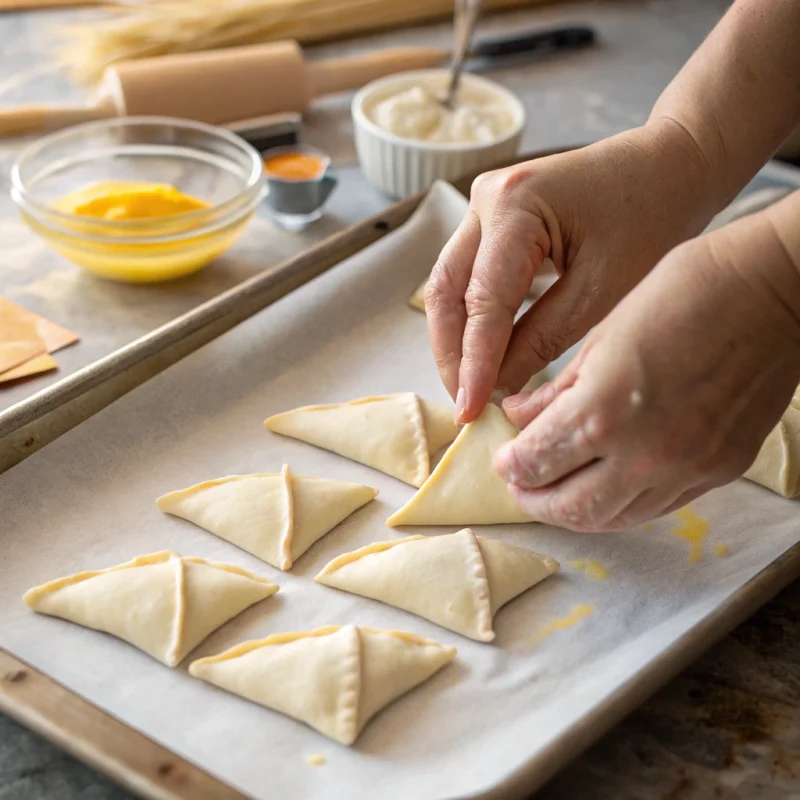
Starting at the wide base of each triangle, roll the dough toward the tip, gently stretching it as you go to create a longer roll. Once rolled, slightly curve the ends inward to form the iconic crescent shape.
Shaping Tip: Keep the tip of the dough tucked underneath the roll to prevent it from unraveling during baking.
The Second Proof: Getting the Perfect Rise
Place the shaped Gipfeli on a baking sheet lined with parchment paper, leaving enough space between each for them to expand. Cover them loosely with a damp cloth and let them rise in a warm, draft-free spot for about 45 minutes to an hour, or until they look puffy and nearly doubled in size.
Baking Tips for Flawless Results
Preheat your oven to 375°F (190°C) and prepare an egg wash by whisking together one egg and a tablespoon of milk. Brush the tops of the Gipfeli generously with the egg wash to give them a shiny, golden finish. Bake for 15–20 minutes or until the Gipfeli are beautifully golden and the layers appear crisp and flaky.
Pro Tip: Rotate the baking sheet halfway through baking to ensure even coloring.
For more delicious recipes, check out the Ultimate Barbecue Shrimp Recipe on Makouri Recipes. It’s a perfect complement to any brunch featuring these buttery Gipfeli!
Variations and Fillings for Gipfeli
Sweet Fillings: Chocolate, Almond, and More
While traditional Gipfeli are delightful on their own, adding sweet fillings can take them to the next level. Some popular options include:
- Chocolate: Place a small piece of dark or milk chocolate at the wide base of the dough before rolling it up.
- Almond Paste: Spread a thin layer of almond paste for a nutty, luxurious twist.
- Fruit Preserves: A dollop of jam, such as apricot or raspberry, brings a burst of fruity sweetness to each bite.
Pro Tip: Avoid overfilling to ensure the filling doesn’t seep out during baking.
Savory Options: Cheese, Herbs, and Bacon
For a more robust snack or meal option, experiment with savory fillings:
- Cheese: Add a sprinkle of shredded Gruyère, Parmesan, or cheddar before rolling.
- Herbs: Incorporate fresh or dried herbs like rosemary, thyme, or chives into the dough or filling.
- Bacon Bits: Cooked and crumbled bacon adds a salty, smoky contrast to the buttery layers.
Savory Variations: Pair savory Gipfeli with soups or salads for a hearty meal idea.
Flavored Dough Ideas: Lemon Zest, Vanilla, and Cinnamon
For a subtle twist on the classic dough, infuse it with additional flavors:
- Lemon Zest: Adds a fresh, citrusy note perfect for spring.
- Vanilla Extract: Enhances the dough’s natural sweetness without overpowering.
- Cinnamon: Mix ground cinnamon into the flour for a warm, cozy flavor.
These variations make Gipfeli versatile and suitable for every occasion, from casual breakfasts to elegant brunches. Let your creativity shine as you experiment with different combinations!
Serving and Storing Gipfeli
Serving Suggestions for Breakfast and Brunch
Freshly baked Gipfeli are best enjoyed warm, straight from the oven. Their golden crust and tender, buttery layers pair wonderfully with a variety of accompaniments:
- Classic Pairings: Serve with a selection of jams, honey, or butter for a traditional Swiss breakfast experience.
- Beverage Matches: Enjoy with a robust coffee, herbal tea, or a glass of freshly squeezed orange juice.
- Brunch Platters: Include Gipfeli in a spread with scrambled eggs, smoked salmon, fresh fruits, and cheese for an elegant meal.
For a fun twist, set up a DIY Gipfeli bar, allowing guests to choose their toppings and fillings.
Storing and Reheating Tips
To preserve their freshness and texture, follow these storage tips:
- Cool Completely: Allow Gipfeli to cool to room temperature before storing to prevent sogginess.
- Airtight Storage: Place in an airtight container or wrap individually in plastic wrap. Store at room temperature for up to 2 days.
- Freezing: For longer storage, freeze Gipfeli in a single layer on a baking sheet. Once frozen, transfer them to a freezer bag and store for up to 3 months.
Reheating Tip: To enjoy again, preheat your oven to 350°F (175°C) and warm the Gipfeli for about 5 minutes. This restores their crisp exterior and fluffy interior, making them taste as fresh as the day they were baked.
Troubleshooting Common Issues
Dough Shrinking While Rolling
If your dough resists rolling and springs back, it likely needs more time to rest. Overworked gluten can make the dough tight and elastic. To fix this:
- Cover the dough with plastic wrap and let it rest for 10–15 minutes before trying again.
- Keep your workspace and rolling pin lightly floured to prevent sticking.
Pro Tip: Avoid excessive kneading during preparation to keep the dough pliable.
Preventing Butter Leakage
Butter seeping out during baking can ruin the layers and texture of your Gipfeli. To avoid this:
- Ensure the butter and dough remain cold during lamination and shaping.
- Refrigerate the shaped Gipfeli for 10–15 minutes before baking to firm up the butter.
- Seal the dough edges tightly during the lamination process to trap the butter inside.
Perfecting Flaky Layers
Achieving the signature flaky layers of Gipfeli requires precision:
- Roll the dough gently and evenly, using light pressure.
- Don’t skip the resting periods between folds, as they allow the gluten to relax and maintain clear, defined layers.
- Use high-quality, high-fat butter for the best results.
By addressing these common pitfalls, you can ensure your Gipfeli turn out beautifully flaky and irresistible every time. Remember, practice makes perfect, so don’t hesitate to try again if your first batch isn’t flawless!
FAQs About Gipfeli and Related Recipes
What is the Difference Between a Croissant and a Gipfeli?
Although Gipfeli and croissants look similar, they have distinct differences. Croissants, originating in France, are typically lighter, airier, and sweeter due to higher butter content and added sugar. In contrast, Swiss Gipfeli are denser, less sweet, and often have a sturdier texture. They are also less flaky, making them more versatile for savory and hearty fillings.
What is a Mandelgipfel?
A Mandelgipfel is a variation of Gipfeli that features a delightful almond flavor. The dough is enriched with almond paste or almond cream filling and is sometimes topped with slivered almonds for added texture and visual appeal. Mandelgipfeli are often enjoyed as a sweet treat alongside coffee or tea, offering a nutty twist on the classic Swiss pastry.
What is the Recipe for Mangria?
Mangria is a fruity cocktail made by blending red wine, brandy, and fruit juice (such as orange or pineapple). Popular additions include sliced fruits like oranges, lemons, and apples to enhance the drink’s visual and flavor profile. Chill the mixture and serve over ice for a refreshing twist on traditional sangria.
What is the Thunderbrew Recipe?
The Thunderbrew recipe originates from gaming lore and represents a fictional, hearty ale. To recreate it, combine a dark beer or ale with honey, cinnamon, and a splash of whiskey for warmth. Simmer the mixture gently, serve hot, and enjoy as a unique, cozy drink inspired by fantasy traditions.
Cultural Significance of Gipfeli
The Role of Gipfeli in Swiss Cuisine
In Switzerland, Gipfeli isn’t just a breakfast pastry; it’s a beloved tradition that symbolizes the comfort of home and the joy of sharing meals. Often enjoyed with a warm cup of coffee or tea, this iconic treat is a staple at Swiss bakeries and breakfast tables alike. The versatility of Gipfeli, from its plain version to variations like Mandelgipfel, ensures its place in Swiss culinary culture.
Regional Variations Across Switzerland
The Gipfeli takes on subtle variations across Switzerland’s linguistic regions:
- German-Swiss Gipfeli: Focuses on buttery richness with a slightly denser texture.
- French-Swiss Croissants: Lean toward a lighter, flakier style, influenced by French baking traditions.
- Italian-Swiss Versions: Often incorporate citrus zest or nutty fillings for a unique twist.
Each variation reflects local preferences, showcasing how this humble pastry has evolved into a symbol of Swiss culinary pride. Whether enjoyed on its own or paired with other Swiss delights, Gipfeli remains a timeless favorite.
Conclusion: Why Gipfeli is a Must-Try Recipe
Mastering the art of making Gipfeli at home is a rewarding experience that combines tradition, creativity, and the irresistible aroma of freshly baked pastries. This Swiss staple, known for its buttery layers and versatile flavors, brings joy to any breakfast or brunch table.
Whether you stick to the classic version or experiment with sweet and savory fillings, Gipfeli offers endless possibilities for customization. With a bit of patience and practice, you can create pastries that rival those from the finest Swiss bakeries.
Beyond its delightful taste, Gipfeli carries a rich cultural heritage that celebrates the Swiss love for food and community. Sharing these pastries with loved ones adds warmth to any gathering, making them more than just a treat—they’re a tradition worth savoring.
So, roll up your sleeves, gather your ingredients, and start your Gipfeli baking journey today. You’ll not only discover a new skill but also create memories and delicious moments to cherish. Happy baking!
